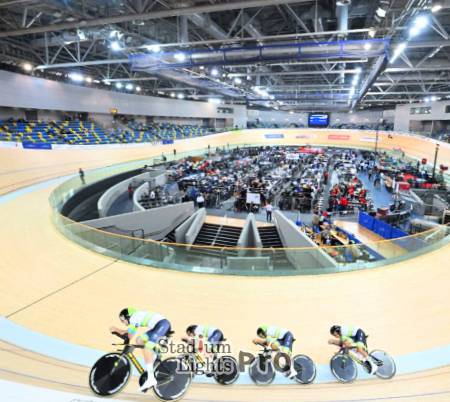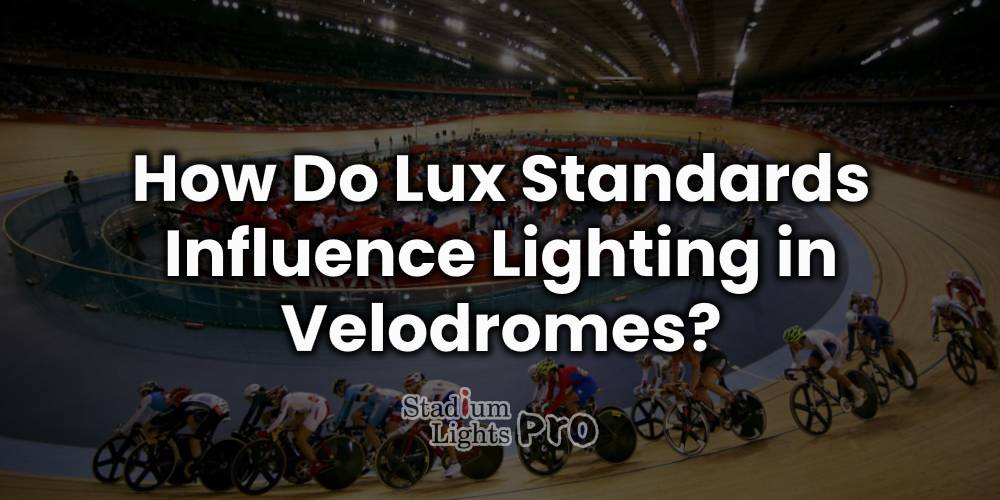From ensuring safety for athletes to enhancing the viewing experience for spectators, and ensuring high-quality broadcasts, the lighting system must meet stringent criteria. Lux levels, the types of lighting used, their arrangement, and the required standards all play a significant role in creating the ideal environment for the sport. This detailed guide explores various elements that make up velodrome lighting, covering everything from light types to design considerations and regulatory standards.
Table of Contents
ToggleComparison of Lighting Types
| Lighting Type | Energy Efficiency | Lifespan | Heat Production | Initial Cost | Maintenance Costs | Suitability for Velodromes |
|---|---|---|---|---|---|---|
| Incandescent | Low | Short
(1000 hours) |
High | Low | High (Frequent replacements) | Not recommended due to high heat and low efficiency. |
| Halogen | Moderate | Moderate (2000-4000 hours) | High | Moderate | Moderate | Provides brighter light but still inefficient compared to modern technologies. |
| Fluorescent | Moderate | Moderate (10,000 hours) | Moderate | Moderate | Moderate | Energy-efficient but may not provide ideal light quality. |
| LED | High | Long
(50,000+ hours) |
Low | High | Low | Best option for velodromes due to energy efficiency, longevity, and quality of light. |
Lux Requirement
 Lux is a unit of measure used to describe the intensity of light that illuminates a surface. In a velodrome, lux requirements are critical for ensuring that both athletes and spectators can see the track and the surrounding environment clearly. The intensity of lighting in different areas of the venue, including the track and spectator stands, must be meticulously designed to avoid shadows and provide consistent visibility across the entire venue.
Lux is a unit of measure used to describe the intensity of light that illuminates a surface. In a velodrome, lux requirements are critical for ensuring that both athletes and spectators can see the track and the surrounding environment clearly. The intensity of lighting in different areas of the venue, including the track and spectator stands, must be meticulously designed to avoid shadows and provide consistent visibility across the entire venue.
Minimum Lux Levels
The minimum lux levels for velodromes are set to ensure that there is adequate visibility for both athletes and spectators. For a basic training session, the lux levels may not need to be as high. However, for professional races, especially those broadcasted on television, the lighting must be precise, ensuring that every moment of the event is clearly visible.
Training Lux Levels
In a typical training session, athletes do not need the same level of lighting as they would during a competitive event. For training purposes, lighting levels of around 300 to 500 lux are often sufficient. This provides adequate visibility for athletes, allowing them to practice effectively while maintaining a lower operating cost for the venue.
Competitive Event Lux Levels
For competitive events, the lighting requirements are higher. Minimum lux levels of 800 to 1500 lux are typically required to meet broadcast standards and ensure that the event is clear and well-lit from every angle. These elevated lux levels ensure high-quality television broadcasts and provide athletes with a safe and visible track.
Lux for Broadcast and High-Definition Events
In televised events, the lux levels may be further increased to accommodate high-definition broadcasting standards. At least 1500 lux is commonly recommended for events that are expected to be broadcast on HD television, with some premium events pushing these lux levels even higher for improved clarity and visibility in detailed shots of the action.

Lighting Standards for Velodromes
When designing the lighting system for a velodrome, it is crucial to ensure that the lighting meets both international and local standards. These standards are established by governing bodies like the International Cycling Union (UCI) and local regulatory agencies to ensure that the venue is safe, functional, and visually optimized for both athletes and spectators.
International Standards for Velodrome Lighting
The UCI sets strict guidelines for the lighting of velodromes, focusing on lux levels, uniformity of light, and glare control. According to UCI standards, a competitive velodrome should have a minimum lighting level of 800 lux for general events, with higher lux requirements for televised events. These standards help ensure that the lighting is sufficient for athletes to perform safely and that the audience and broadcast cameras have a clear and uninterrupted view of the action.
Uniformity and Glare Control
One of the most important factors in velodrome lighting design is ensuring uniformity. Light must be distributed evenly across the track to avoid shadows and dark spots that could impair visibility. Inadequate light distribution could result in accidents or decreased performance, especially for fast-moving athletes. Furthermore, glare from overly bright lights can be distracting and dangerous. Lighting design must take these factors into account to create a safe and high-quality environment.
Local Regulations and Codes
In addition to international standards, local building codes and regulations must also be adhered to when designing velodrome lighting systems. These codes often specify additional requirements, such as emergency lighting in case of power failure, restrictions on light pollution, and requirements for energy efficiency. Local regulations ensure that the venue complies with safety standards and minimizes its environmental impact.
Compliance with Standards
Compliance with these standards is crucial for velodromes, as failure to meet the minimum lighting requirements can result in penalties or even the inability to host events. Adhering to lighting standards ensures that athletes can perform at their best in a safe environment, while spectators and broadcasters enjoy high-quality visuals that meet international standards.
Measurement of Distance and Placement of Lights
The placement of lighting fixtures is critical for achieving the desired lux levels and ensuring that the light is evenly distributed across the velodrome. The distance between lights, the height of the fixtures, and their orientation all contribute to the effectiveness of the lighting design.
Height of Lighting Fixtures
The height at which lighting fixtures are mounted is an important factor in determining the distribution of light across the track and the surrounding areas. Mounting the lights too low can result in uneven lighting and shadows, while placing them too high may reduce the intensity of light on the track, leading to under-illumination.
Typically, lighting fixtures in velodromes are placed between 8 and 15 meters above the ground. The ideal height depends on the size of the venue, the lighting type used, and the specific lux requirements. By optimizing the height of the fixtures, designers can ensure that the light is spread evenly across the venue, providing uniform illumination without creating dark spots.
Distance Between Fixtures
The distance between light fixtures is another critical consideration in lighting design. If fixtures are placed too far apart, certain areas of the track may be inadequately lit. Conversely, placing fixtures too close together can lead to excessive light concentration in certain areas, leading to inefficiencies and potential glare. Proper calculations based on the track’s layout, the lighting technology, and the lux levels required ensure that the lighting is evenly distributed and efficient.
The Design of the Lighting System
Designing a lighting system for a velodrome involves integrating various elements to meet the lighting standards, provide optimal illumination, and create a comfortable environment. Factors like fixture placement, light intensity, and color temperature must all be carefully planned to meet the needs of athletes, spectators, and broadcasters.
Lighting Simulations and Planning
Lighting designers often use advanced computer modeling tools and simulation software to design lighting systems. These tools allow designers to visualize how the lighting will behave in the space, helping them adjust the design to meet the required lux levels and ensure proper light distribution. By simulating the lighting effects before installation, designers can avoid costly mistakes and ensure that the lighting meets the desired standards.
Customization for Different Events
Velodromes may host a wide variety of events, from casual training sessions to high-profile international competitions. The lighting system must be flexible enough to accommodate these different needs. Adjustable lighting controls allow the system to be fine-tuned for different events, ensuring that the track is optimally lit for the specific requirements of each event. Whether the goal is to provide bright, intense lighting for a professional race or a softer, more diffused light for a practice session, the lighting system can be adapted accordingly.
Light Color and Its Impact
The color temperature of the lighting is another key factor in the design of the lighting system. Light color is measured in Kelvins (K), and the right choice of color temperature can enhance visibility and reduce visual discomfort for athletes and spectators.
Ideal Color Temperature for Velodromes
For velodromes, a color temperature in the range of 4000K to 5000K is typically ideal. This cool white light enhances clarity and reduces visual strain, making it easier for athletes to see the track and for spectators to watch
the event. Light with a color temperature below 3000K can appear too warm and distort the visual quality, while light above 5000K can result in eye strain and an unpleasant viewing experience.
By using the right light color, velodromes can optimize visibility and create a comfortable environment for everyone in the venue.
Policies and Following Lighting Requirements
Strict adherence to lighting standards and regulations is required for velodromes to ensure safety, performance, and high-quality events. Compliance with these regulations helps ensure that the venue is fit for hosting competitive events, meets broadcast standards, and adheres to environmental and safety guidelines.
Importance of Adherence to Standards
Failing to meet lighting requirements can result in penalties, loss of accreditation to host international events, and compromised safety. Properly designed and maintained lighting systems help prevent accidents and ensure that the venue is in top condition for athletes and audiences. By following established lighting policies, velodromes maintain their reputation as top-tier venues capable of hosting world-class events.
Conclusion
The design of velodrome lighting is a complex process that must account for a variety of factors to ensure optimal performance and visibility. Lux requirements vary depending on the event type, with higher lux levels required for competitive events, especially those televised. The type of light used—whether incandescent, halogen, fluorescent, or LED—affects everything from energy consumption to maintenance costs. LED lights, with their high energy efficiency, long lifespan, and minimal heat production, are by far the best choice for velodromes.
Standards set by organizations like the International Cycling Union (UCI) help ensure that lighting is consistent and meets the necessary criteria for safe and effective competitions. Proper placement of lights and consideration of factors like glare control and light uniformity are essential for achieving the best lighting quality across the entire venue. Furthermore, compliance with both local and international regulations ensures that velodromes can safely host events while offering a high-quality experience for both athletes and spectators.
By following the right design principles and utilizing the appropriate lighting technologies, velodromes can create an environment that enhances athletic performance, provides clear visibility for spectators, and meets the technical demands of broadcasting.

